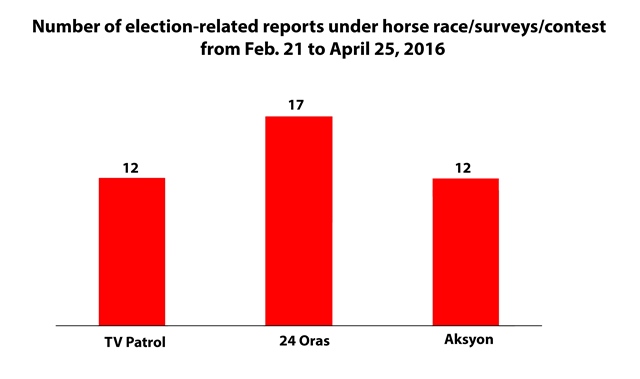Electoral Cockfight and Horserace

Screengrab from GMA-7’s Unang Hirit, May 4, 2016.
PREVIOUS CMFR monitors have pointed out the dominance of election-related reports in primetime newscasts (“Campaign Trail Story Dominates Election News”). But the reports tend to be repetitive, providing mere updates on the candidates’ activities, among them such details as where they’ve been and what they said while on the campaign trail.
Reviewing the newscasts (ABS-CBN 2’s TV Patrol, GMA-7’s 24 Oras, and TV5’s Aksyon) from April 11 to April 17, CMFR found nothing much has changed. During the period, television reportage still followed much of the same formula.
This focus on the campaign trail could have provided the media the opportunity to point out the candidates’ take on policy and developmental issues as well as their platforms, if any. Instead the reports monitored were more interested in getting each candidate’s adverse opinion of his or her rivals, as well as emphasizing who’s leading and who’s ahead as reported by the public opinion surveys.
Against Each Other
Among the three primetime newscasts, 24 Oras had the most number (17) of reports pitting presidential aspirants against each other (see Figure 1) while TV Patrol and Aksyon both ran 12. Some examples:
- Liberal Party candidate Mar Roxas assailing opponents Vice President Jejomar Binay and Davao City Mayor Rodrigo Duterte for corruption allegations and human rights violations, respectively
- Binay tagging Duterte as “berdugo”
- Duterte tagging Binay as “berdugo ng pera ng Makati”
- Roxas saying Duterte is full of empty promises
- Duterte saying Binay and Roxas have issues on graft and corruption
The Ties that BindTHE FEBRUARY election monitor of CMFR had already noted the ties that could possibly explain the favorable media mileage senatorial aspirant Martin Romualdez has been getting, particularly in The Standard. Sitting as chairman MST Management Inc., the paper’s publisher, is the Leyte representative’s brother Philip Romualdez, who also happens to be the husband of Alexandra Prieto-Romualdez, president and chief executive officer of the Philippine Daily Inquirer. From February 21 to April 25, CMFR monitored the coverage by the Manila-based newspapers (Philippine Daily Inquirer, The Philippine Star, Manila Bulletin, The Manila Times, Daily Tribune, The Standard, BusinessMirror, BusinessWorld, and Malaya Business Insight) of Romualdez and found that The Standard had been giving him considerable attention, followed by the Inquirer…[Read More] |
Figure 1. Number of election-related reports under horse race/surveys/contest
Print reports also focused on the cockfight theme. In an election monitor last March 22 (“On the Campaign Trail”), CMFR noted that print media also tend not only to emphasize the candidates’ attacks on each other but even to provoke them, resorting to the widely known practice journalists call “sabong.”
After being away from the public eye for almost two months, Senator Miriam Defensor-Santiago returned to the campaign trail and spoke in a campaign rally with Senator Bongbong Marcos in Iloilo City and then in Baguio City. Reports in all news programs observed that she looked visibly stronger and healthier.
News organizations dedicate a team to cover each campaign. The perils of being embedded are obvious. These journalists and campaign staff spend days and even off hours together. The pack mentality can take hold of different news teams who will send back the same angles and takeaways from the day’s events, resulting in a uniformity in the reporting in different programs.
Given the length of the campaign, the mutual dependence between sources and media can create affinities that can get in the way of more enterprising news coverage. One should understand how such synergy can get in the way of independent and autonomous reporting on the road.
Judging from the quality of reports so far, assigning dedicated teams may not be worth the expense it involves. The yield has been disappointing, with few reports willing to break away and do something different.
Reporting the Surveys: Who’s Ahead, Who’s Behind
The horse race is the other favored news frame for the campaign. Like TV news programs, print accounts merely point out who’s ahead and who’s behind, with little or no analysis.
Social Weather Stations (SWS) and Pulse Asia have regularly scheduled surveys which they release to the media. A total of four surveys were released in two weeks of April. SWS released the results of their surveys on the presidential elections on April 17 (Bilang Pilipino SWS Mobile Survey) and April 28 (BusinessWorld-SWS April 2016 Pre-Election Survey), while Pulse Asia released on April 24 (ABS-CBN Pre-Election National Survey) and April 26 (Pulse Asia Research ‘s April 2016 Nationwide Survey).
In “Election Surveys: Beyond the Numbers and the “Horse Race,” CMFR also noted how both print and broadcast only report the results of surveys without even bothering to explain the terms the survey firms often use, such as “margin of error,” “confidence level,” and “statistical tie,” among others, which can be discussed by the experts doing the surveys. The media tend to speak to spokespersons and other staff working for a candidate, recording only their predictable responses.






Leave a Reply